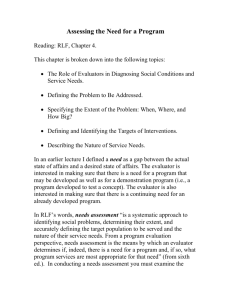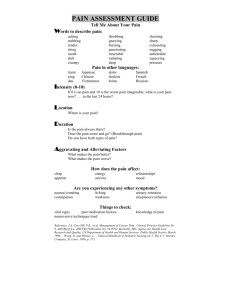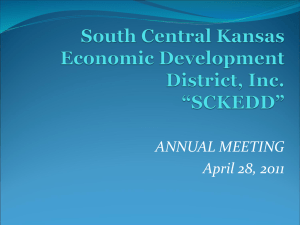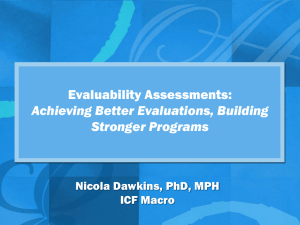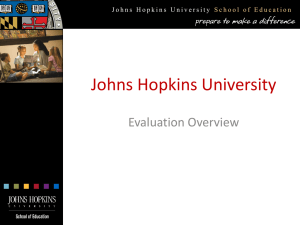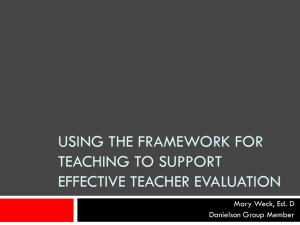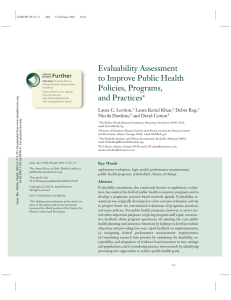Expressing and Assessing Program Theory
advertisement
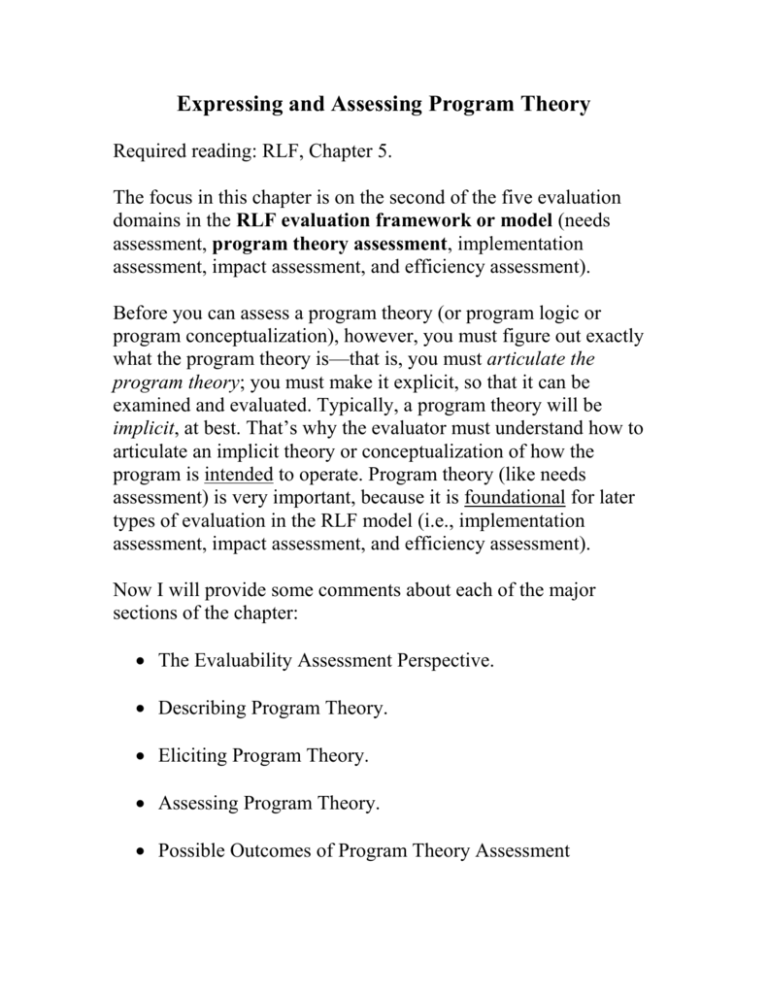
Expressing and Assessing Program Theory Required reading: RLF, Chapter 5. The focus in this chapter is on the second of the five evaluation domains in the RLF evaluation framework or model (needs assessment, program theory assessment, implementation assessment, impact assessment, and efficiency assessment). Before you can assess a program theory (or program logic or program conceptualization), however, you must figure out exactly what the program theory is—that is, you must articulate the program theory; you must make it explicit, so that it can be examined and evaluated. Typically, a program theory will be implicit, at best. That’s why the evaluator must understand how to articulate an implicit theory or conceptualization of how the program is intended to operate. Program theory (like needs assessment) is very important, because it is foundational for later types of evaluation in the RLF model (i.e., implementation assessment, impact assessment, and efficiency assessment). Now I will provide some comments about each of the major sections of the chapter: The Evaluability Assessment Perspective. Describing Program Theory. Eliciting Program Theory. Assessing Program Theory. Possible Outcomes of Program Theory Assessment The Evaluability Assessment Perspective RLF trace the origin of theory-driven evaluation to Joseph Wholey’s (1970s) writings on evaluability assessment. Joseph Wholey is an important evaluation theorist, so you should try to remember his name as well as his ideas. By the way, the first author of your textbook (Peter Rossi) and one of his students Huey Chen were also very important in getting the theory-driven evaluation movement started (e.g., see Chen and Rossi’s 1983 article, “Evaluating with sense: The theory-driven approach” in Evaluation Review, 7, 283-302.) Also, the second author of RLF (Mark Lipsey), who joined the authors in the 6th edition of your book, is a major advocate of theory-driven evaluation and has written extensively on the topic (one of my favorite Lipsey writings is Theory as Method: Small Theories of Treatments, 1993, in New Directions for Program Evaluation, no. 57, pp. 5-38). Getting back to Joseph Wholey. Wholey was one of the most important evaluators working with the federal government during the 1960s and 1970s. It is during this time that he first developed the concept of evaluability assessment. Here are three definitions of evaluability assessment: 1. Assessing whether the program is ready to be managed for results, what changes are needed to do so, and whether the evaluation would contribute to improved program performance (from Foundations of program evaluation, 1991, Sage Pub.) 2. Negotiation and investigation undertaken jointly by the evaluator, the evaluation sponsor, and possibly other stakeholders to determine whether a program meets the preconditions for evaluation and, if so, how the evaluation should be designed to ensure maximum utility (from RLF, p.168). 3. Evaluability assessment explores the objectives, expectations, and information needs of program managers and policymakers; explores program reality; assesses the likelihood that program activities will achieve measurable progress toward program objectives; and assesses the extent to which evaluation information is likely to be used by program management. The products of evaluability assessment are: (1) a set of agreed-on program objectives, important sideeffects, and performance indicators on which the program can realistically be held accountable; and (2) a set of evaluation/management options which represent ways in which management can change program activities, objectives, or uses of information in ways likely to improve program performance (from Joseph Wholey’s, 1979, Evaluation: Promise and Performance, page xiii, Washington DC: Urban Institute) As you can see, there are several rules or concepts that come out of the evaluability assessment perspective: 1. Work with management or others who are likely to use evaluation results, and determine their informational needs. 2. Do not evaluate a program if it is not ready to be evaluated. Are the objectives realistic given program conceptualization and resources? If not, tell your client the program is not ready to be evaluated. Conduct an evaluation only when someone is going to use the evaluation results (especially managers who have influence over the development and operation of the program). 3. Articulate the program theory. When the intended program theory is carefully examined and combined with needs assessment data, you will understand whether the program has a chance of working. If a program is based on a faulty conceptualization, it is going to fail no matter how vigorously you implement it. In an earlier chapter, we called this problem theory failure. 4. Make sure that measurable performance indicators can be obtained if you are going to recommend that a program be evaluated. 5. Different program circumstances call for different levels or types of evaluation. Wholey calls this the sequential purchase of information. Here are the three key types of evaluation discussed by Wholey (not covered in RLF): o 1) Rapid feedback evaluation which is a quick assessment of program performance in terms of agreedupon objectives and indicators; it also provides designs for more valid, reliable, full-scale evaluation. o 2) Performance monitoring which is the establishment of an ongoing process and outcome program monitoring system. o 3) Intensive evaluation which is a rigorous experimental evaluation to test the validity of causal assumptions linking program activities to outcomes. 6. During the evaluability assessment you should determine whether there should be (a) no program evaluation, (b) a rapid feedback evaluation, (c) performance monitoring, or (d) an intensive evaluation. Describing Program Theory In this section an overview of the RLF view of program theory is provided. An excellent pictorial of general program theory is shown in Exhibit 5-C. (It would be a good idea to know how to draw this model, in general and for your exam.) The service arena is the point at which the program and target population interact, and it is these interactions that are expected to result in the proximal and distal outcomes. Here are the major program theory components: The program theory is composed of the impact theory and the process theory. The impact theory. This is the theory showing the results or outcomes that are supposed to be produced by the program activities. These outcomes include both proximal outcomes (more immediate or direct results) and distal outcomes (more ultimate or longer term outcomes that result from the proximal outcomes). The action theory (or action hypothesis) specifies the expected immediate or proximal outcomes of the program actions; the conceptual theory (or conceptual hypothesis) specifies the expected distal or longer term outcomes. Note the possibility of theory failure (the program is implemented, but the theory is faulty; hence, the expected results do not occur) and implementation failure (the planned program services are not delivered; hence, the expected results do not occur). The next two components of the program theory (service utilization and organizational plan) are known as the program process theory and they require process evaluation. The service utilization plan is the expectations about how program clients will become engaged with the program and participate in program activities. It describes the programtarget transactions (and what is behind those transactions) from the perspective of the program target participants. It explains what the participants must do if they are to be part of the program. The organizational plan is the expectations about how the program will be organized and maintained. It describes the program-target transactions (and what is behind those transactions) from the perspective of program management. It explains what the organization must do to deliver and maintain an effective program. If all of this sounds a little complex, take a look at the example given in Exhibit 5-G (p. 147). The inputs and activities represent the program organization. The outputs represent the service utilization. And remember, the process theory includes both the program organization and the service utilization. Next is the impact theory (labeled Outcomes) which includes the initial outcomes, intermediate outcomes, and the longer term outcomes. Eliciting Program Theory An articulated program theory is an explicitly stated version of program theory that is spelled out in some detail as part of a program’s documentation and identity or as a result of efforts by the evaluator and stakeholders to formulate the theory (RLF’s definition). An articulated program theory is what I sometimes call an explicit theory. Note that program theory as discussed in this chapter refers to the theory of the program as it is intended to operate. Your goal here is to describe, in detail, how a program is supposed to be organized and implemented (process theory) and what is supposed to happen (impact theory) if the program is implemented according to the process theory. Typically a program will not be fully articulated. What will be present will be an implicit program theory, which is a largely unstated theory that is implicit in the program assumptions and operations. RLF define implicit program theory as the set of “assumptions and expectations inherent in a program’s services and practices that have not been fully articulated and recorded.” Before discussing how to articulate a program theory, I will remind you, one more time, of the components of program theory. A program theory is composed of a process theory and a impact theory. The impact theory is the causal theory explaining how the program brings about changes in outcomes. The impact theory should include discussion of both proximal and distal outcomes. The process theory is the explanation of how the program is supposed to operate, and it includes a service utilization plan (i.e., how, from the perspective of the target population, program clients will make contact with the program and engage in program activities until completion of the intended services) and an organizational plan (i.e., how, from the perspective of program management, the program will perform its required functions and how it will obtain and organize the necessary resources for effective performance). Again, you should review the pictorial representation of RLF’s view of program theory on page 140 of your text. It should be obvious that there are a lot of things that need to be examined when you are articulating or describing a program theory (i.e., when you transforming an implicit theory into a, fully described, explicit theory of how the program is intended to operate). Here are RLF’s key thoughts on articulating (i.e., describing) a program theory. First, you need to come up with a clear definition of the program, its objectives, and its boundaries that is negotiated and agreed upon by the evaluator and the primary stakeholders. Next, you can use some or all of the following procedures for articulating or explicating or describing the program theory. Articulation is an iterative and successive process, where you obtain information, listen to stakeholders’ views and reactions to the developing program theory, obtain more information and listen to stakeholders’ reactions to the revised program theory, and continue this process until there is some agreement on the description of the program theory (i.e., how the program is intended to operate). You will want to use some or all of the following approaches: Review program documents and other secondary or extant data. A few examples are written descriptions of the program, the authorizing legislation for the program, grants, annual reports, brochures explaining the program, mission statements, lists of program goals and objectives, program manuals, and job descriptions. Take a big empty box with you, and fill it up with these data. Interview program personnel and other stakeholders. You should interview clients of the program (i.e., people who have completed the program services), other members of the target population who have not yet completed the program services, program staff and management, funding agencies and program sponsors, and anyone else with information about the conceptualization and operation of the program. It is important for you to obtain and listen to the different perspectives of these information providers and try to come up with an agreed upon description of the program as it is intended to operate. Make site visits and observe the program. A strength of collecting data through observation is that you can see what people are doing, rather than having to only rely on what they say they do. During observation, you can “explore the program reality firsthand.” This process also allows you (the evaluator) to provide an independent perspective on what is done in the program. Look for any discrepancy between the program theory you have described up to this point (what is supposed to be done) and the program reality that you observe (what is actually done). You need to be thinking about whether the program theory is generally realistic given the program circumstances and local context. Here are some topics to explore during your data collection expedition: Determine the program goals and objectives. Rather than directly asking program personnel and stakeholders “What are the objectives of your program?” you may want to ask about the expected outcomes and then work your way back to the objectives. You will want to identify impact theory goals and objectives (e.g., program participants will pass a test on drug knowledge; program participants will improve their communication skills; program participants will not resume drug use after leaving the program). You also will want to identify process theory goals and objectives (e.g., all high school students arrested for drug use will enter program XYZ; at least 90% of program participants will complete all six program sessions; counselors and program leaders will be trained in program content and delivery). Throughout the process of data collection, be on the lookout for possible side effects or unintended outcomes that may result from the program. Determine the program functions, components, and activities. The focus here is primarily on describing the intended program process. In other words, what is going to be done to bring about the expected outcomes? Examine each of the components of the service utilization and organizational plans, and list the activities participants must engage in. Determine the logic or sequence that links the program functions, activities, and components. How are the various program components and activities temporally sequenced? What program activities require special coordination? What is the logic of the program impact theory and what kinds of conceptual sequencing does it imply. What is the logic model of the program? Are the activities and outcomes measurable? What success criteria or standards will apply to the outcomes? What are the factors that are under the control of program personnel and what are the factors that are not under their control, and what are program personnel planning on doing about the second set of factors? Try to DRAW out a graphical display or set of displays that depict the program logic and theory. Note that it is essential that you corroborate the theory description that you have now developed with the primary stakeholders again and again until you have agreement. If agreement is not reached, revise the theory description and follow the above steps again. If no agreement can be made after this, perhaps the program is not evaluable. Perhaps some organizational development strategies would help if the organization is willing to look at itself and do some intra-organizational work. Assessing Program Theory Once you fully describe the program theory and all of its components, the next step is to assess it (i.e., to evaluate it). (Remember the four steps in the logic of evaluation?) I suggest that you evaluate the program theory both formatively (looking for possible improvements) and summatively (looking for overall worth and merit). RLF list several ways to access the articulated program theory (i.e., the now explicit theory of how the program is intended to work). First, assess the program theory in relation to the identified problem and social needs. Compare the intervention specified in the program theory with the social needs the program is intended to address. Ask, “Is this a good theory compared to what is needed to address the specific problem of the specific target population who is embedded in this specific context?” Hopefully your program theory description will be specific enough to allow you to know whether it fits the specific characteristics of the clients and their circumstances. That’s why theory articulation should be specific and detailed. In assessing the impact theory (i.e., the causal theory), compare the specifics of the impact theory to what the needs assessment data indicate is required to improve the local conditions and problem. In assessing the process theory (i.e., the theory of how the program is maintained and implemented), compare the assumptions associated with the service utilization and organizational plans with the needs assessment data that relate to the target population’s opportunities to obtain services and how they are likely to react to the program. In short, “Do you conclude that the intended program process will be responsive to the characteristics and needs of the target population?” Second, assess the program theory by using logic and by determining the plausibility of the theory assumptions, the logic of the various theory components, and the theory’s overall logic. The evaluator will do some of this, but it is essential that stakeholders also be involved. RLF suggest that you answer these two questions: 1. Is the program theory well defined? Check to see that are of the parts of the theory are specific, concrete, and clear. 2. It the program theory reasonable? If you really want to do a good job here, you can assemble a panel of expert reviewers to evaluate the program theory. The review panel can be composed of you (the evaluator), representatives from the program staff, other key stakeholders, and outside experts such as university researchers and administrators of similar programs. If you decide to put together a review panel, RLF have even provided you with a series of open-ended focus group or interview questions that you can use! Here they are: Question 1. Are the program goals and objectives well defined, and are they measurable? Question 2. Are the program goals and objectives feasible, and is it realistic to assume that they can actually be attained as a result of program action? Question 3. Is the change process presumed in the program theory (especially the impact theory) plausible? For example, do you agree with the cause-and-effect chain? Question 4. Are the program procedures for identifying members of the target population, delivering service to them, and sustaining that service through completion well defined and sufficient? Question 5. Are the components, activities, and functions of the program well defined and sufficient to attain the intended program goals and objectives? Question 6. Are the resources allocated to the program and its various components and activities adequate? Use the expert panel to help you in making evaluative judgments for each of these six questions. Third, assess the program theory by comparing it with evidence from research and practice. Is the program theory compatible with research evidence (both applied research and basic research) and practical experience of others? You should do a careful literature search examining publications on similar programs, looking at how those programs were designed (especially their program theory), looking at the effectiveness of these programs, and then comparing this with the program theory you are evaluating. Note that this is one reason why the results of program evaluations need to be published and/or cataloged. We need to build knowledge, not start from scratch each time we develop a new program and evaluate it. When looking at published research, also pay attention to meta-analyses because these articles report the success level based on many programs of a certain type, rather than just one program. If there are no publications or information on programs just like the one you are evaluating, you may still find useful information from programs that have something in common (by analogy). You can also examine relevant social and behavioral science theory. For example, in evaluating a drug education program, you might find some relevant information about programs that used some of the same component strategies (e.g., teaching goal-setting, how to resist peer pressure, how to resolve conflicts, how to communicate successfully with family and peers, etc.). Relevant social and behavioral science theory will also help (e.g., attitude change theory, research of barriers and resistance to change, social learning theory, labeling theory, etc.). Fourth, assess the program theory by comparing it with what you observe when you examine the program in operation. Supplement and corroborate your findings and conclusions by making site visits, to make sure it appears that the program theory will work at the local sites. Do the outcomes seem realistic for the local population? Does the process seem appropriate for the local program and local population? Possible Outcomes of Program Theory Assessment The outcome of the process described in this chapter is a description of the program theory and an evaluation (i.e., judgment of the worth and merit) of that program theory. The evaluator can also provide formative evaluative information by pointing out what components or specific program parts or activities need to be revised, redesigned, or reconceptualized. It is important that the stakeholders participate each step of the process outlined in this chapter because they must “buy into” the program theory, they must implement the program theory, and they are the ones that you hope will use the results of your theory assessment. In contrast, note that some evaluators and program personnel are not interested in understanding the specifics of a program theory. They are content if they obtain the desired outcomes, even if they do not know exactly why the outcomes occurred. This contrasting approach to evaluation is called black-box evaluation. What is inside of the box (i.e., the program is not examined), but the outcomes are examined. In other words, you may know that the “program package” worked (i.e., the program resulted in the desired outcomes), but you can’t explain what parts of the package were responsible for the outcome. Michael Scriven is generally quite happy with a black-box evaluation. The approach that RLF, Wholey, and I tend to prefer is the approach presented in this chapter and lecture. This approach is sometimes called theory-driven evaluation. Scriven calls it clearbox evaluation because you document what is going on in the box. The approach also is sometimes called logic-modeling. At the same time, there will be times when black-box evaluation will be fine and is all that is needed. Once again, remember the approach to evaluation that I advocated early in the semester: contingency or needs based evaluation (i.e., the appropriate type of evaluation will vary depending on the specific context, contingencies, and information needs). This is basically the same thing RLF recommend when they talk about tailoring an evaluation to the current needs.
